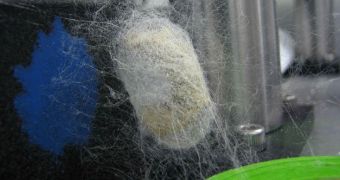Silkworms and spiders may seem like small insects to us, but they are the keepers of a secret that scientists would pay a mind-boggling sum of money to learn. These creatures are the only ones that can produce natural silk, a material that is highly-flexible, yet tougher than steel and Kevlar. The compound has been with us for centuries, and yet no one has managed to get additional insights into how it is produced. Replicating the process could lead to the development of a new class of high-performance materials, say researchers at the Tufts University.
The goal of silk research worldwide is to gain the ability to consistently replicate it, and also enhance its production synthetically. There are numerous research groups who are looking closely into how the spiders spin their web, but thus far only cheap copies of the material have been produced in the laboratory. The global state of this field of research is the subject of a new report by Tufts researchers Fiorenzo G. Omenetto and David L. Kaplan. Their work appears in the July 30 issue of the esteemed journal Science, the US National Science Foundation (NSF) reports.
The paper also takes a close look at the challenges that still remain to be surpassed, as well as at the reasons why synthetic silk production is so appealing to the international scientific community. The two authors say that they are perfectly aware that the material is nothing more than “a relatively simple protein processed from water.” Regardless, its complexity is apparently beyond our capacity of replication. Omenetto and Kaplan explain that silk changes its properties depending on a wide variety of factors, including for example the speed with which it is spun, the temperature and humidity leves outside, and so on.
The thing that throws researchers off-balance is that fact that the silk is not produced inside the body, and then stored inside special compartments, for special use. Rather, it would appear that both spiders and silkworms simply pull it out of special glands. The movements which they use for the job are very precise, and the patterns in which they move are always the same. While vast numbers of observations hours have gone into observing the creatures as they produce silk, “there are still significant knowledge gaps in understanding how to reverse-engineer silk protein fibers,” the two authors conclude.

 14 DAY TRIAL //
14 DAY TRIAL //